


|
We offer Alaska raft trips that offer scenic views, wildlife viewing, fishing, and whitewater.
Custom group Alaska rafting adventures are available on request. If have interested in something special or participating in an exploratory expedition, please contact us with your ideals or to see what plans are being made.
Kongakut River - 10 day Arctic National Wildlife Refuge Rafting Safari. Explore Alaska's remote Arctic National Wildlife Refuge (ANWR) by raft on the "river of caribou". Our trip coincides with the annual migration of the 130,000-strong Porcupine caribou herd and passes through some of the world's most pristine wilderness.
Lake Creek - 7 day Whitewater Rafting and Fishing Adventure. Our favorite fly-in wilderness adventure river, great combination exciting whitewater and great Alaska fishing. Lake Creek offers almost continuous Class II/III whitewater with a few Class IV rapids, five species of salmon, rainbow trout and arctic grayling.
Chulitna River - 4 day Denali Raft Adventure. An excellent family adventure and sampling of Alaska's best wilderness and geography at a casual pace. We travel through Denali State Park, upper Susitna Valley and take out near Trapper Creek, a historic gold mining town. |
|
|
|
 |
Tufted Puffin - Fratercula Cirrhata and Horned Puffin - Fratercula Corniculata
Basic Facts
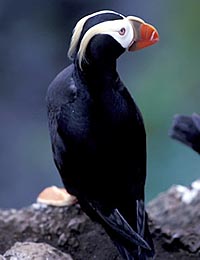 |
| Tufted Puffin |
Puffins belong to the Alcid family, a group of diving birds that swim underwater using their wings for propulsion and their feet for steering. Two species of puffins nest in Kenai Fjords National Park, the horned and the tufted.
The puffins we see from the tour boats are ready for the breeding season. The horned puffin has pure white feathers around the face, large flashy beak plates and the characteristic fleshy black horn above the eye. The tufted puffin also has white facial feathers and colorful beak plates, but the addition of two tufts of yellow feathers atop its head distinguishes this species. Both puffins stand 15 inches tall, the tufted puffin is heavier at 1.7 pounds than the horned puffin at 1.4 pounds. The weight difference seems slim, but for a bird that must beat its wings 400 times a minute to stay aloft, it is very big.
Tufted puffins arrive in the rookery islands about mid-May. Horned puffins usually follow one week later. Both types of puffins begin their breeding season by gathering in large groups on the water. Puffins mate for life, and it is thought that these gatherings may reunite mated pairs.
Range and Sightings
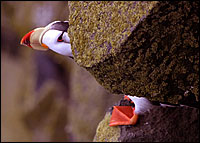 |
| Horned puffin |
Tufted puffins range from Big Sur California in the eastern north Pacific to Hokkaido Japan in the western north Pacific and northward through the Aleutian Islands. Horned puffins live in breeding colonies as far south as Queen Charlotte Island in British Columbia, and their range extends eastward to eastern Siberia and the Sea of Okhotsk and north to coasts in the Chukchi Sea, including Point Barrow. Puffins do not migrate over long distances, but make their home on the open waters over the continental shelf when their nesting time ends. This habit is referred to as nomadic.
Locally, the cliffs at the base of Beehive Islands I and II in the Chiswell Islands have the heaviest concentration of nesting puffins—both tufted and horned. Abuzz with puffin activity, Beehive Islands I and II are named for the constant flurry of puffins surrounding them.
We also find horned puffins at Caines Head, where a small group (10-20) nests around a little cove at the south end of the headland. On the east side of the bay, horned puffin nests appear at the base of the Resurrection Peninsula, just south of the Fox Island spit. Emerald Cove is one of the busiest horned puffin nesting areas. Tufted puffins show up just past Cheval Island.
Food and Survival Strategies
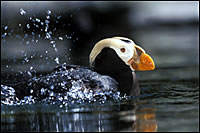 |
| Tufted Puffin |
The puffin diet consists mostly of white capelin (74 percent for tufted and 61 percent for horned). Sandlance and other small fish make up the rest of the horned puffin's diet. The tufted puffin eats euphasiids (small, shrimp-like crustaceans) small squid, and sandlance (listed in order of frequency) in addition to white capelin.
Both bald eagles and peregrine falcons prey on puffins. To protect themselves from airborne attack, puffins form distinct flight patterns between nesting areas and feeding areas. They fly in large groups and in patterns that roughly resemble a wheel, making it hard for a bird of prey to find and attack an individual.
Reproduction and Young
Puffins come to land only for nesting purposes. The puffin's return to their offshore islands indicates year-to-year fluctuation of productivity cycles in the near shore waters. A breeding pair of puffins puts its energy into just one egg. This strategy aims for a very high success rate, one that must consider annual changes in food availability. In studies conducted by the U.S. Fish and Wildlife Service, the overall success rate (successful fledging of chick) for tufted puffins was 65 percent and for horned puffins 60 percent.
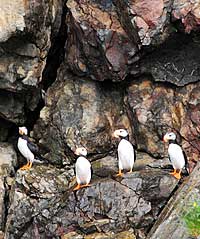 |
| Horned puffin |
Tufted puffins dig burrows three to six feet deep in the tops of islands and headlands, while horned puffins use rock crevices for their nesting sites. Both birds may employ grass and feathers for nesting material or may just use the substrate at hand for their egg laying.
Both adults brood the egg. Upon hatching, parents provide the young chick with a steady diet of fish. Although classic photos show puffins with lots of fish in their mouths, the nutritional value of the fish decreases with size. Adults carry fewer fish at a time and make more trips, in order to feed older nestlings approximately 14 fish per day. When the puffin chicks fledge, they leave the nest at night in order to avoid predators. They flutter down to the water's edge alone and head for the open sea. They won't return to land again for two to three years, when they become breeding adults at the rookery.
Human Connections
The Inuit people of Alaska used puffin skins to make feather-lined parkas. Beak plates were collected and strung together to form rattles used by shaman in rituals. Both the Aleuts and the Inuits sewed beak plates for decoration on the outside of their garments.
More general information on Kenai Fjords National Park is available at:
Kenai Fjords National Park
We would like to thank the NPS for the above information.
 |
Backcountry Safaris
P.O. Box 1397 Seward, Alaska USA 99664
1-907-205-5900 • Fax 1-907-205-5902
 |
Backcountry Safaris is a member of the following trade and travel organizations:
 | |
|
Puffin Related Links |
|
Kenai Fjords Wildlife |
|
Kenai Fjords Birds |
|
Kenai Fjords Related Links |
|
Sea Kayaking Related Links |
|
Kenai Fjords Related Links |
|
Suggested Reading |
|
Kenai Fjords Weather |
|
Current Seward, AK Weather |
|
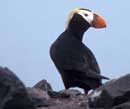 Did You Know? Did You Know?
Horned and tufted puffins are the most popular Alaska seabirds and are easy to recognize with their large colorful bills and comical looks, especially after you see dozens of them depicted on t-shirts and as stuff toys in the local gift shops. The SeaLife Center offers a wonderful opportunity to see puffins "flying" under water and is a highlight of any visit to the Center. |
|












 Did You Know?
Did You Know?